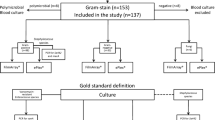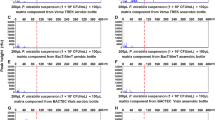Opinion statement
Bloodstream infections remain an important cause of morbidity/mortality worldwide. The diagnosis of these infections is time-consuming, even with the use of automated blood culture systems. Several systems based on molecular biology and, more recently, proteomics have been developed to allow rapid and accurate diagnosis of bloodstream infections. Here, we describe some recently technologies and commercial systems available to detect and to identify microorganisms and bacterial antimicrobial resistance-coding genes from positive blood culture bottles and whole-blood samples. Evaluation of clinical outcomes in multicenter studies and clinical trials with these new tests is warranted in conjunction with antimicrobial stewardship use and programs for interpretation of results to be provided to physicians.
Similar content being viewed by others
References and Recommended Reading
Papers of particular interest, published recently, have been highlighted as: • Of importance •• Of major importance
Laupland KB. Incidence of bloodstream infection: a review of population-based studies. Clin Microbiol Infect. 2013;19(6):492–500.
Vardakas KZ, Anifantaki FI, Trigkidis KK, Falagas ME. Rapid molecular diagnostic tests in patients with bacteremia: evaluation of their impact on decision making and clinical outcomes. Eur J Clin Microbiol Infect Dis. 2015;34(11):2149–60.
Morrell M, Fraser VJ, Kollef MH. Delaying the empiric treatment of Candida bloodstream infection until positive blood culture results are obtained: a potential risk factor for hospital mortality. Antimicrob Agents Chemother. 2005;49(9):3640–5.
Mancini N, Carletti S, Ghidoli N, et al. The era of molecular and other non-culture-based methods in diagnosis of sepsis. Clin Microbiol Rev. 2010;23(1):235–51.
Lupetti A, Barnini S, Castagna B, et al. Rapid identification and antimicrobial susceptibility testing of Gram-positive cocci in blood cultures by direct inoculation into the BD Phoenix system. Clin Microbiol Infect. 2010;16(7):986–91.
Chen J-R, Lee S-Y, Yang B-H, Lu J-J. Rapid identification and susceptibility testing using the VITEK 2 system using culture fluids from positive BacT/ALERT blood cultures. J Microbiol Immunol Infect. 2008;41(3):259–64.
Waites KB, Brookings ES, Moser SA, Zimmer BL. Direct susceptibility testing with positive BacT/Alert blood cultures by using MicroScan overnight and rapid panels. J Clin Microbiol. 1998;36(7):2052–6.
Whitcombe D, Newton CR, Little S. Advances in approaches to DNA-based diagnostics. Curr Opin Biotechnol. 1998;9(6):602–8.
Riedel S, Carroll KC. Early identification and treatment of pathogens in sepsis: molecular diagnostics and antibiotic choice. Clin Chest Med. 2016;37(2):191–207.
Menezes LC, Rocchetti TT, de Bauab CK, et al. Diagnosis by real-time polymerase chain reaction of pathogens and antimicrobial resistance genes in bone marrow transplant patients with bloodstream infections. BMC Infect Dis. 2013;13:166.
•• Quiles MG, Menezes LC, de Bauab CK, et al. Diagnosis of bacteremia in pediatric oncologic patients by in-house real-time PCR. BMC Infect Dis. 2015;15:283. This study describes some in-house molecular tests to diagnose BSIs directly from blood culture bottles and whole-blood samples using real-time PCR
Salimnia H, Fairfax MR, Lephart PR, et al. Evaluation of the FilmArray blood culture identification panel: results of a multicenter controlled trial. J Clin Microbiol. 2016;54(3):687–98.
Ledeboer NA, Lopansri BK, Dhiman N, et al. Identification of gram-negative bacteria and genetic resistance determinants from positive blood culture broths by use of the Verigene gram-negative blood culture multiplex microarray-based molecular assay. J Clin Microbiol. 2015;53(8):2460–72.
Stevenson M, Pandor A, Martyn-St James M, et al. Sepsis: the LightCycler SeptiFast Test MGRADE®, SepsiTestTM and IRIDICA BAC BSI assay for rapidly identifying bloodstream bacteria and fungi—a systematic review and economic evaluation. Health Technol Assess 2016: 1–246.
Sitnik R, Marra AR, Petroni RC, et al. SeptiFast for diagnosis of sepsis in severely ill patients from a Brazilian hospital. Einstein. 2014;12(2):191–6.
Dark P, Blackwood B, Gates S, et al. Accuracy of LightCycler SeptiFast for the detection and identification of pathogens in the blood of patients with suspected sepsis: a systematic review and meta-analysis. Intensive Care Med. 2015;41(1):21–33.
Zboromyrska Y, De La Calle C, Soto M, et al. Rapid diagnosis of staphylococcal catheter-related bacteraemia in direct blood samples by real-time PCR. Plos One 2016; 1–11.
Bispo PJM, de Melo GB, Hofling-Lima AL, Pignatari ACC. Detection and gram discrimination of bacterial pathogens from aqueous and vitreous humor using real-time PCR assays. Invest Ophthalmol Vis Sci. 2011;52(2):873–81.
Loonen AJM, Bos MP, van Meerbergen B, et al. Comparison of pathogen DNA isolation methods from large volumes of whole blood to improve molecular diagnosis of bloodstream infections. PLoS One. 2013;8(8):e72349.
Ellem JA, Olma T, O’Sullivan MVN. Rapid detection of methicillin-resistant Staphylococcus aureus and methicillin-susceptible S. aureus directly from positive blood cultures by use of the BD Max StaphSR assay. J Clin Microbiol. 2015;53(12):3900–4.
Cosgrove SE, Li DX, Tamma PD, et al. Use of PNA FISH for blood cultures growing gram-positive cocci in chains without a concomitant antibiotic stewardship intervention does not improve time to appropriate antibiotic therapy. Diagn Microbiol Infect Dis. 2016;86(1):86–92.
• Patel R. New developments in clinical bacteriology laboratories. Mayo Clin Proc 2016. This review provides a comprehensive overview of available laboratory testing for use in clinical microbiology.
Monteiro J, Inoue FM, Lobo APT, et al. Fast and reliable bacterial identification direct from positive blood culture using a new TFA sample preparation protocol and the Vitek® MS system. J Microbiol Methods. 2015;109:157–9.
Carvalhaes CG, da Silva ACR, Streling AP, et al. Detection of carbapenemase activity using VITEK MS: interplay of carbapenemase type and period of incubation. J Med Microbiol. 2015;64(8):946–7.
Jordana-Lluch E, Giménez M, Quesada MD, et al. Evaluation of the broad-range PCR/ESI-MS Technology in Blood Specimens for the molecular diagnosis of bloodstream infections. PLoS One. 2015;10(10):e0140865.
Bacconi A, Richmond GS, Baroldi MA, et al. Improved sensitivity for molecular detection of bacterial and Candida infections in blood. J Clin Microbiol. 2014;52(9):3164–74.
Pfaller MA, Wolk DM, Lowery TJ. T2MR and T2Candida: novel technology for the rapid diagnosis of candidemia and invasive candidiasis. Future Microbiol. 2016;11(1):103–17.
Grumaz S, Stevens P, Grumaz C, et al. Next-generation sequencing diagnostics of bacteremia in septic patients. Genome Med. 2016;8(1):73.
Vlek ALM, Bonten MJM, Boel CHE. Direct matrix-assisted laser desorption ionization time-of-flight mass spectrometry improves appropriateness of antibiotic treatment of bacteremia. PLoS One. 2012;7(3):e32589.
Clerc O, Prod’hom G, Vogne C, et al. Impact of matrix-assisted laser desorption ionization time-of-flight mass spectrometry on the clinical management of patients with Gram-negative bacteremia: a prospective observational study. Clin Infect Dis. 2013;56(8):1101–7.
Huang AM, Newton D, Kunapuli A, et al. Impact of rapid organism identification via matrix-assisted laser desorption/ionization time-of-flight combined with antimicrobial stewardship team intervention in adult patients with bacteremia and candidemia. Clin Infect Dis. 2013;57(9):1237–45.
Aitken SL, Hemmige VS, Koo HL, et al. Real-world performance of a microarray-based rapid diagnostic for Gram-positive bloodstream infections and potential utility for antimicrobial stewardship. Diagn Microbiol Infect Dis. 2015;81(1):4–8.
Bork JT, Leekha S, Heil EL, et al. Rapid testing using the Verigene Gram-negative blood culture nucleic acid test in combination with antimicrobial stewardship intervention against Gram-negative bacteremia. Antimicrob Agents Chemother. 2015;59(3):1588–95.
Suzuki H, Hitomi S, Yaguchi Y, et al. Prospective intervention study with a microarray-based, multiplexed, automated molecular diagnosis instrument (Verigene system) for the rapid diagnosis of bloodstream infections, and its impact on the clinical outcomes. J Infect Chemother. 2015;21(12):849–56.
Banerjee R, Teng CB, Cunningham SA, et al. Randomized trial of rapid multiplex polymerase chain reaction-based blood culture identification and susceptibility testing. Clin Infect Dis. 2015;61(7):1071–80.
•• Vincent J-L, Brealey D, Libert N, et al. Rapid diagnosis of infection in the critically ill, a multicenter study of molecular detection in bloodstream infections, pneumonia, and sterile site infections. Crit Care Med. 2015;43(11):2283–91. This multicenter study evaluated the polymerase chain reaction/electrospray ionization-mass spectrometry technology for BSIs diagnosis and affirm that these technologies can result in potentially cause of altered treatment of these infections
• Carlesse F, Cappellano P, Quiles MG, et al. Clinical relevance of molecular identification of microorganisms and detection of antimicrobial resistance genes in bloodstream infections of paediatric cancer patients. BMC Infect Dis. 2016;16 :–462. This study highlights the clinical relevance of using molecular tests to diagnosing BSIs in a specific population
Author information
Authors and Affiliations
Corresponding author
Ethics declarations
Conflict of Interest
Milene Quiles declares that she has no conflicts of interest.
Bruno Boettger declares that he has no conflicts of interest.
Antonio Carlos Campos Pignatari declares that he has no conflicts of interest.
Human and Animal Rights and Informed Consent
This article does not contain any studies with human or animal subjects performed by any of the authors.
Additional information
Key Points
Rapid and accurate molecular methods are required for diagnosis of BSIs and can contribute for an appropriate antimicrobial therapy institution.
Validation of new molecular methodologies and platforms in the microbiology diagnostic laboratory is essential to evaluate the accuracy and sensibility of these tests before implementation in the clinical routine.
Stewardship programs should be institutionalized for implementation and evaluation of new diagnostic tests in BSIs.
This article is part of the Topical Collection on New Technologies and Advances in Infection Prevention
Rights and permissions
About this article
Cite this article
Quiles, M., Boettger, B. & Pignatari, A.C.C. Update in Bloodstream Infection Diagnosis Using New Methods in Microbiology. Curr Treat Options Infect Dis 9, 1–10 (2017). https://doi.org/10.1007/s40506-017-0104-1
Published:
Issue Date:
DOI: https://doi.org/10.1007/s40506-017-0104-1




